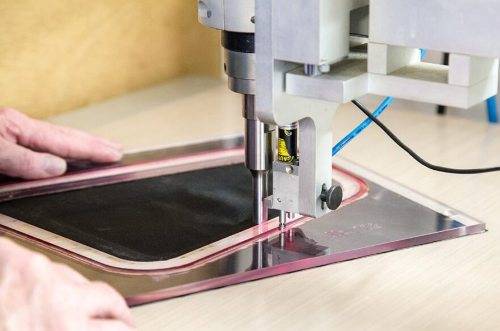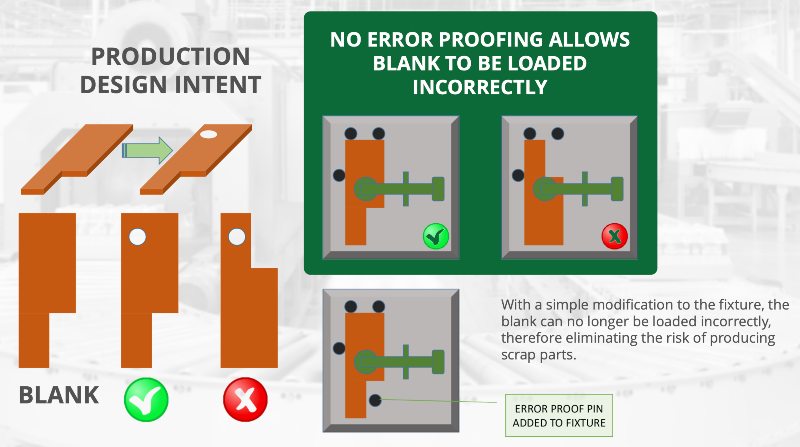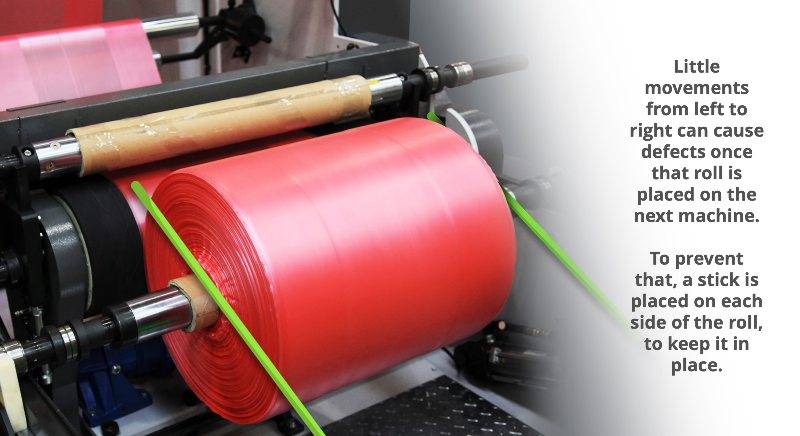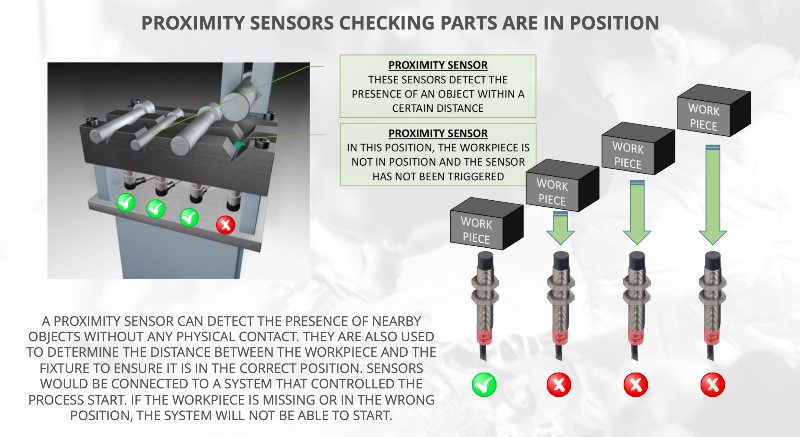
Mistake proofing is an important tool used by manufacturers for analyzing the assembly process and finding ways in which errors may occur. Then measures are put in place to prevent the errors, thereby improving product quality and reliability coming off the production line.
Any manufacturer can implement mistake proofing in their operations, so let’s explore what it is, its origins, why it’s desirable, and some examples in this post…
What is mistake proofing?
Human error is normal and to be expected when using production operators for assembly, but this doesn’t mean that it can’t be reduced. Your engineers will analyze your production processes and look for areas where mistakes might occur.
You continuously and proactively try to figure out what the source/s of the issues you’re finding in the process is, and then once you’ve figured it out you’ll make strides to eliminate them for good. Mistake proofing isn’t a band-aid on the process, it’s more like finding a problem and getting rid of it forever.
If areas are found where a mistake could occur, such as a screw being inserted incorrectly, for example, the engineers will develop a new method or a physical device such as a jig or fixture that holds the production pieces in the correct way every time so that the orientation guarantees that the operator inserts the fastener correctly, a go-no-go gauge, or even advise the implementation of automation in the factory in order to rule out the use of operators for a particular process.
By doing so the goal is to permanently eliminate any kinds of errors or mistakes that can happen in that process, improve quality, make your operators’ lives easier, and get better-quality products into customers’ hands.
When is it required?
Basically, if you want or need to reduce the chances of mistakes occurring during production it will be worthwhile implementing an initiative like this. These scenarios may call for it:
- If products are being made where any defects could lead to safety issues and injury, like medical devices
- High-value items where defects will not be tolerated by the consumer
- Companies who find a production step where human error is causing defects
- When mistakes occur when a production piece is being handed off to the next worker in line (who is about to start their process on it)
What sort of processes can it be used on?
Almost any process! You can analyze and find errors to fix in hardware, software, and, in some cases, even a service process and this kind of fail-safing can definitely be implemented as part of a six sigma or lean manufacturing initiative. We widely use it here at Agilian when manufacturing electronic devices, and that includes hardware and software processes.
How did this way to find and fix errors come about?
Mistake proofing actually started when a Toyota engineer by the name of Shigeo Shingo came up with the term poka-yoke or ポカヨケ (PO-ka yo-KAY) in the 1960s.
He was one of the pioneers of continuous process improvement and one of the reasons why Toyota’s quality is so great among most car manufacturers is partly due to his work.
The origin of the practice comes from when:
Shingo redesigned a process in which factory workers, while assembling a small switch, would often forget to insert the required spring under one of the switch buttons. In the redesigned process, the worker would perform the task in two steps, first preparing the two required springs and placing them in a placeholder, then inserting the springs from the placeholder into the switch. When a spring remained in the placeholder, the workers knew that they had forgotten to insert it and could correct the mistake effortlessly. (Source)
Two important points to remember about poka-yoke are:
- It needs to prevent issues 100% of the time.
- It should not give production operators more work to do, meaning that it should be seamless.
How is poka-yoke implemented?
Depending on what you’re doing in terms of the process, there will be different kinds of poka-yoke implementations. We’re mainly focusing on the electronic manufacturing side of things which means a root cause analysis and corrective action kind of process that would actually eliminate errors for good.
The ASQ has a five-step process for implementing poka-yoke:
- Obtain or create a flowchart of the process. Review each step, thinking about where and when human errors are likely to occur.
- For each potential error, work back through the process to find its source.
- For each error, think of potential ways to make it impossible for the error to occur. Consider:
- Elimination: eliminating the step that causes the error.
- Replacement: replacing the step with an error-proof one.
- Facilitation: making the correct action far easier than the error.
- If you cannot make it impossible for the error to occur, think of ways to detect the error and minimize its effects. Consider inspection methods, setting functions, and regulatory functions expanded on below.
- Choose the best mistake-proofing method or device for each error. Test it, then implement it. Three kinds of inspection methods provide rapid feedback:
- Successive inspection is done at the next step of the process by the next worker.
- Self-inspection means workers check their own work immediately after doing it.
- Source inspection checks, before the process step takes place, that conditions are correct. Often it’s automatic and keeps the process from proceeding until conditions are right.
Is it proactive or reactive?
Mistake proofing can be done after a problem is found, but as with many activities in manufacturing, it’s often better to tackle it proactively and implement it when you’re creating the flowchart of the production processes. Here you may have identified a process step where human error is very high because an operator is doing assembly or testing, and humans make mistakes. Even if it’s one mistake per hour, this process step needs to be fixed with poka-yoke otherwise over time these mistakes add up.
There are also some other times when one operator needs to hand off to another operator at the end of their process step. There is a chance of errors here because the handoff could be done wrong, delayed, or never happen at all! If so, quality issues occur and/or the production is slowed down or stopped. Hand-off process steps are, therefore, great candidates for mistake-proofing and maybe even automation to cut out the human error element.
Is it a collaborative effort?
Often certain team members need to collaborate together to put in place a new poka-yoke initiative. An assembly line is a good example of this. To mistake-proof the assembly line you need a manufacturing, software, product, and test engineer, as well as an assembly operator and QA staff. All of them work together to brainstorm what could go wrong and what they need to do to get rid of that mistake forever and come up with ideas like creating jigs, automating, reducing or increasing the time for that person to work on one process so that they’re doing a good job, and putting an inspection at a point in the process where we can check what is happening, or at the end of the line to specifically monitor that one step. They might also implement self-inspection so the operator does the job, but then also must inspect for quality to make sure that the process is sound. As you can see, these ideas draw on the different team members’ specialities.
Some mistake-proofing examples
For manufacturers, arguably the most important poka-yoke activities happen in production on the assembly line. You’ve got operators who wake up in the morning, go to work, and do the same thing every day. It’s normal that occasionally they start work when they’re still sleepy or not feeling well resulting in them working a little bit slower or making more errors. For example, they’re supposed to put a fastener in this socket, but they accidentally put it in a different socket, and so on. Poka-yoke examines all these processes individually and an engineer will say ‘what is she doing?’ ‘Okay, she’s connecting this connector to this connector and can it be done wrong? ‘Yes, it can be connected backwards.’
They’ll then assess the effect of this mistake and depending on how serious it is, such as a small mistake now causes big problems later on in production, they’ll devise a fix for the process that stops the mistake. For example, they might come up with two solutions: a jig that only allows the operator to put one connector on one side and then another on the other side in the correct way only or to automate the whole process so that the human is not even involved and a machine does the whole the process instead.
In our production lines, we try our best to implement mistake-proofing everywhere but, just in case an error occurs, we have a red light, yellow light, and green light detection system in place on some lines. Green light means the process is running without any kind of problem, if it’s running when an issue is possible then you could have a yellow light blinking, and then once the issue becomes serious and the line actually stops you will have a red light blinking and a buzzer that indicates that there’s a serious problem that somebody needs to inspect and fix this problem urgently. Sometimes an orange light might be used, too, meaning that production is running, but attention is required in terms of testing, QA checks, and so on.
For software, an example might be where people accidentally overwrite each others’ work in a shared database. In order to avoid this, a mistake-proofing measure can be put in place where only one person at a time can actually update a field in the database or a cell in an excel sheet.
Note: since we cannot show real examples from our productions due to strict NDAs, we found some good examples from other sources:
A jig that only allows ultrasonic welding in the correct areas
Here you can see an example of a jig, in this case for ultrasonic welding. Notice how the jig holds the part in position so welding can only be done in the correct places almost like a stencil for children’s drawings:

(Image source: Ardmel.com)
An error-proof pin is added to a fixture to force a piece to be loaded correctly
In this example, a blank piece of material can be loaded into a fixture the wrong way round causing a mistake. But once a pin is added in the right position to the fixture, blanks can only be positioned correctly by operators:

Preventing mistakes in automated processes
Mistake proofing can be used in automated processes, too, even when human operators aren’t there to make mistakes. Machines and automated lines can suffer from problems occasionally, so we can put measures in place to alert staff that a problem needs their attention or to prevent issues completely.
An example of the latter is where a roll of extruded plastic moves around slightly as it’s being wound, causing defects in the roll:

Here you can see that the roll is stabilized with some sticks to prevent movement from side to side…simple, yet effective!
Automated systems can be prevented from starting a process if a workpiece is not in the correct position by proximity sensors. Here’s an example:

(Examples from CMC’s eBook: 14 examples of mistake-proofing devices)
Conclusion
One of the things that manufacturers need to remember is that even the smallest mistake can have catastrophic effects in some cases. Poka-yoke is very valuable because by doing this you are eliminating the chance of errors ever happening again and it’s not only peace of mind for that process, but also it prevents other failures and errors from happening, and it really contributes to quality, reliability, and performance of the product once it’s in users’ hands.
If you have hardware failures, you can think of reliability testing as a way of doing poka-yoke, too. By doing reliability testing you’re detecting the issues that could go wrong and fixing them forever.
*****
If you have any questions about preventing errors or need help developing and manufacturing your products in China, get in touch with us any time!



